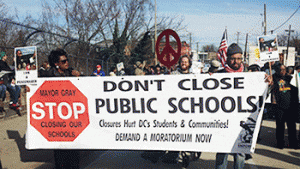
In May 2013, ralliers gather for a hearing in a case against the city for the proposed closure of 15 D.C. public schools. Photo courtesy of Empower D.C.
Back in 1994, Parents United, a once highly influential parent-led advocacy group in Washington, D.C., weighed in on a curious new phenomenon that city leaders were introducing known as “charter schools” (so new in fact that they used quotation marks when writing about them). Given the sluggish pace of change the group had come up against in its almost two decades of advocating for public education, Parents United tentatively wrote in its newsletter that the new innovation “simply becomes one more strategy for improving schools for our children.”
Since that time, however, charter schools have gone from being just “one more strategy” to a central tenet of a powerful education reform agenda that is guiding policy in D.C. as well as many other cities across the country. Now enrolling nearly half of all public school students in the nation’s capital, charters have grown at a steady clip in a city often considered at the cutting edge of reform trends.
But charters may have reached a critical tipping point in D.C. Concerned that the city may become the next New Orleans, an essentially all-charter district that has raised concerns over its level of public accountability and mixed improvements for underserved students, some locals have banded together to defend the city’s long-embattled and withering neighborhood school system. Through the newly formed Coalition for D.C. Schools and Communities (C4DC), a number of local community and parent groups have come together to redirect a reform agenda that they see as overly reliant on school choice. C4DC is holding candidate forums, developing information tools for parents and education advocates, and issuing responses to new education policy and legislation.
In addition to the value they place on neighborhood schools as core building blocks of communities that are essential to civic life, supporters also point out some pragmatic concerns. The lottery systems are frenzied, and as one local mom described in a magazine article, “soul-crushing.” C4DC members argue that stronger neighborhood options, available as a matter of right, can offer greater enrollment predictability to families and education leaders.
Reformers have forcefully argued that charters have freed families—particularly those of lower-income backgrounds—from antiquated attendance boundaries that cage students into attending schools that are often segregated and poorly performing. However, research has shown that more affluent families typically benefit the most from choice, since they more reliably have the resources and time to navigate the system. Thus having the guarantee of attending a quality school in one’s own neighborhood serves as a safety net for those families less likely to be able to take advantage of choice mechanisms.
The new coalition may not spell a clear comeback for neighborhood schools in the city’s intensely competitive education marketplace. But the continued relevance of neighborhood schools in the era of charters has given parents, community leaders, and decision-makers a reason to pause and reconsider the path of education reform in D.C.
Context of a Comeback
The fact that neighborhood schools still enjoy some level of popular support has emerged as something of a revelation in D.C. The combined impact of school choice and gentrification has deeply altered the relationship between schools and communities, making the neighborhood model sometimes appear passé in a city that is rapidly changing.
Over the years, local policymakers have tried to broaden school choice by making attendance zones more porous, enhancing magnet programs, and, most notably, expanding the number of charter schools. According to the National Alliance of Public Charter Schools, D.C.‘s charter sector now enrolls 44 percent of public school students—the third highest proportion of any system in the nation. As a result of all these tweaks, local reports indicate that only about a quarter of students attend the local school assigned to them based on residence.
Everyday manifestations of the city’s erratic education landscape are readily observable. In the early morning, as rush hour announces its arrival with the inevitable traffic bottlenecks and mass transit delays, commuters observe what locals refer to as the daily “exodus,” “exportation,” or “diaspora” of students traveling from the city’s eastern end, which has the highest concentration of black and lower-income families, west in pursuit of quality schools. Even in some more affluent neighborhoods, school children disperse each day. One middle-class parent I spoke to shared a version of a common anecdote. Among a dozen of his son’s friends who gather to play at the local playground, “every single one goes to a different school.” With so many options, enrollment patterns have become highly unpredictable, posing challenges to a variety of education policy and planning processes.
The changing role of neighborhood schools is further complicated by another trend that now permeates almost all aspects of urban life in D.C.: gentrification. While gentrification’s impact on neighborhoods by now has a fairly predictable narrative—shifting racial and class dynamics, rising real estate costs, the displacement of lower-income residents—what the impact will be on public schools has been more open to speculation. Decades after “white flight” devastated many urban centers, it is unclear whether the return of more affluent families will support or further erode a neighborhood system of schools.
Offering one take, the authors of a recent U.S. News & World Report story assert that the more affluent families coming to D.C. are simply eschewing their local schools for charter options. “Wealthier parents see school choice as their top priority,” the authors write, “often resulting in students attending schools in different neighborhoods even with a successful traditional public school in their area.”
But based on my own observations and research, that is not necessarily the case. Some of the loudest voices supporting neighborhood schools belong to recently arrived, young, middle-class, and predominately white parents who are investing considerable time and energy in their local schools. For example, Andy, an outspoken public school dad with young children, wrote up his views on the importance of neighborhood schools for Recess, a local education blog. “From getting to know your neighbors’ kids to reaching across divides of race, class, and language,” he writes, “these bonds not only cultivate meaningful social ties, but strengthen neighborhood families’ ability to advocate for education dollars. If neighborhoods matter to you, so should neighborhood schools.”
More than “Voting with Their Feet”
In D.C., it is easy to point to swelling wait-list numbers for the ever-increasing number of charter schools and conclude that families are enthusiastically “voting with their feet” and leaving neighborhood schools in the dust. Recent enrollment counts, however, suggest that is changing, as demand is grows for many neighborhood schools as well. But the most vocal challenges to the supposed conventional wisdom of the popularity of school choice in D.C. have shown up in contentious policy processes that have forced the city to confront what the future holds for its neighborhood schools.
Mass school closures are among the most explosive phenomena in contemporary urban education. Since 2008, the shuttering of more than three dozen D.C. schools identified as “underutilized,” which served almost exclusively black and Latino students, has ignited an intense public outcry. Communities mobilized in various ways, issuing moratoriums and petitions, holding demonstrations, lobbying local officials, and even suing the school district over the allegedly discriminatory implications of school closures. But those who fought the closures felt that their arguments for sustaining neighborhood schools were simply not valued or appreciated. Leading a group of residents during the 2013 round of closures, Eboni-Rose Thompson recalled that their proposal requesting the city to fund more attractive programming in their neighborhood schools “was dismissed as nostalgic” by school system leaders. In the end, most communities found their efforts unsuccessful and in the closing of their schools saw a condemnation and outright disinvestment from the traditional ideal of neighborhood schools.
On the heels of the most recent round of school closures, however, another policy process opened up the possibility to shake up the city’s schools in an unexpected way. In late 2013, for the first time in four decades, the city government set in motion a comprehensive review of student assignment and school boundary policies. The much anticipated process would determine how students are assigned to attend public schools—a set of policies influencing a host of school factors including access, choice, and segregation, not to mention broader ripple effects on real estate values and transportation patterns.
Over the course of the 10-month community engagement process, more than a thousand parents, community members, and educators debated policy options that could potentially send the city down one of two divergent paths: becoming a pure choice system or maintaining a neighborhood system of schools. The process became a rallying point for those concerned with a broad range of long-simmering educational issues in the District, including limited access to high-quality schooling options and a polarizing school choice environment. From the wide-ranging conversations evolved policy recommendations that clearly made an equitable system of neighborhood schools a centerpiece of any future planning—an outcome few had anticipated. In an interview, one official involved with the process reflected that they were soon confronted with fierce pushback from participants on any proposals that were focused on increasing school choice. The final recommendations developed through the process included provisions for equitably investing in high-quality neighborhood schools in every part of the city, re-opening schools that had recently been closed, creating set-aside spots for at-risk students at higher-performing schools, and a complementary system of choice to allow for access and mobility. Although the student assignment process did not turn out to be an upheaval of the current educational order, it did clearly indicate that residents wanted school improvement to shift away from a focus on choice toward addressing more fundamental issues of education quality.
Mobilizing a “Bubbling Desire”
Even as it becomes harder to ignore the burgeoning support for neighborhood schools, community leaders are realistic about the challenges they face. As an education organizer working with the city-wide group, Empower DC, Daniel del Pielago has observed that “all the pieces are being put into place to move away from this [neighborhood] system” in communities of color, noting such persistent issues as the inequitable funding allocations for fixing deteriorating school buildings. Others list numerous reasons why their vision may not become reality: well-resourced and staffed charter advocacy groups, unsympathetic local media, and a lack of political will from city officials. Still other residents wonder if things are simply too far gone. Thompson observes that while most people want quality neighborhood schools, “it’s kind of a question of if it’s a luxury or a necessity, or if it’s something that’s even realistic to attain.”
Despite their sometimes sobering view, community leaders have felt emboldened by what they see as a growing consensus that the city should not do away with neighborhood schools. Matt Frumin, an attorney by day and longtime schools advocate, has taken a lead role in galvanizing the nascent Coalition. “We’ve seen in D.C. that there is a bubbling desire to ensure that we have great matter-of-right schools in all parts of the city with predictability,” he says. A moment later he is quick to admit, however, that this desire is “not organized.” Nonetheless, there are at least a few things that communities report doing to see this “bubbling desire” foment into something more lasting:
- School and community engagement. At the school level, residents have taken to advocating for funding and facility upgrades, and outreach and marketing efforts that bolster enrollment in neighborhood schools. Beyond these fairly scattered efforts, community leaders have also attempted to shape the direction of education policy, such as the boundary revision process. By participating in opportunities to make their voices heard, they are helping to generate a change agenda that invests in a neighborhood system of schools.
- Shaping the conversation. Local community leaders recognize that much of their work has been reactive as they have pivoted to respond to a steady stream of new education mandates. As they take on a more proactive role, they are introducing a new way of talking about education challenges. One notable example is that many parents and community members are eager to shed the delegitimizing label of being “anti-charter”—a kiss of political death in D.C. Instead, some have attempted to diplomatically position themselves as “pro-collaboration,” advocating for measures that would engender greater coordination and planning across the traditional and charter sector in order to ensure that families benefit from quality school choice rather than bear the brunt of unbridled competition.
- A commitment to equity. Even though community groups across the city have established some common ground across divides of race and class, as well as of newer and longer-term residents, leaders also assert that the unique needs of their respective communities requires a recognition of what makes them different. Thompson, whose community has witnessed a significant erosion of its neighborhood schools, expressed concern that because the experiences of other parts of the city are “completely different than ours,” members of the broader coalition must ensure that they are truly “speaking the same language.” Similarly, del Pielago sees his organizing work as “inspiring folks to join in these types of efforts” but without being “tokenized.” Frumin readily recognizes that challenges facing schools in D.C.‘s affluent enclaves, where he himself lives, are “much more modest than the big picture issues.” Working in coalition though, he says, has helped diverse members develop an awareness of inequality and the interrelated nature of public education in the city.
If neighborhood schools are to make a comeback in a city where they were until recently thought to be quaint and outdated, locals will still have to confront some persistent challenges. In supporting a neighborhood model, they must address the potential retrenchment of school segregation and strike a balance with school choice. In navigating these challenges, local community leaders say they are doubly cautious. As the nation’s capital, D.C. has often served as a laboratory for new education policies. Locals are well aware—and hopeful—that their own struggles to carve out a place for neighborhood schools on the reform agenda may catch the attention of other communities and policymakers across the nation.

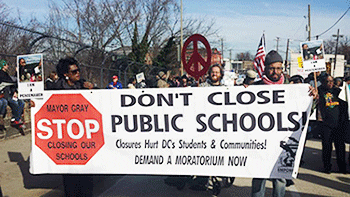
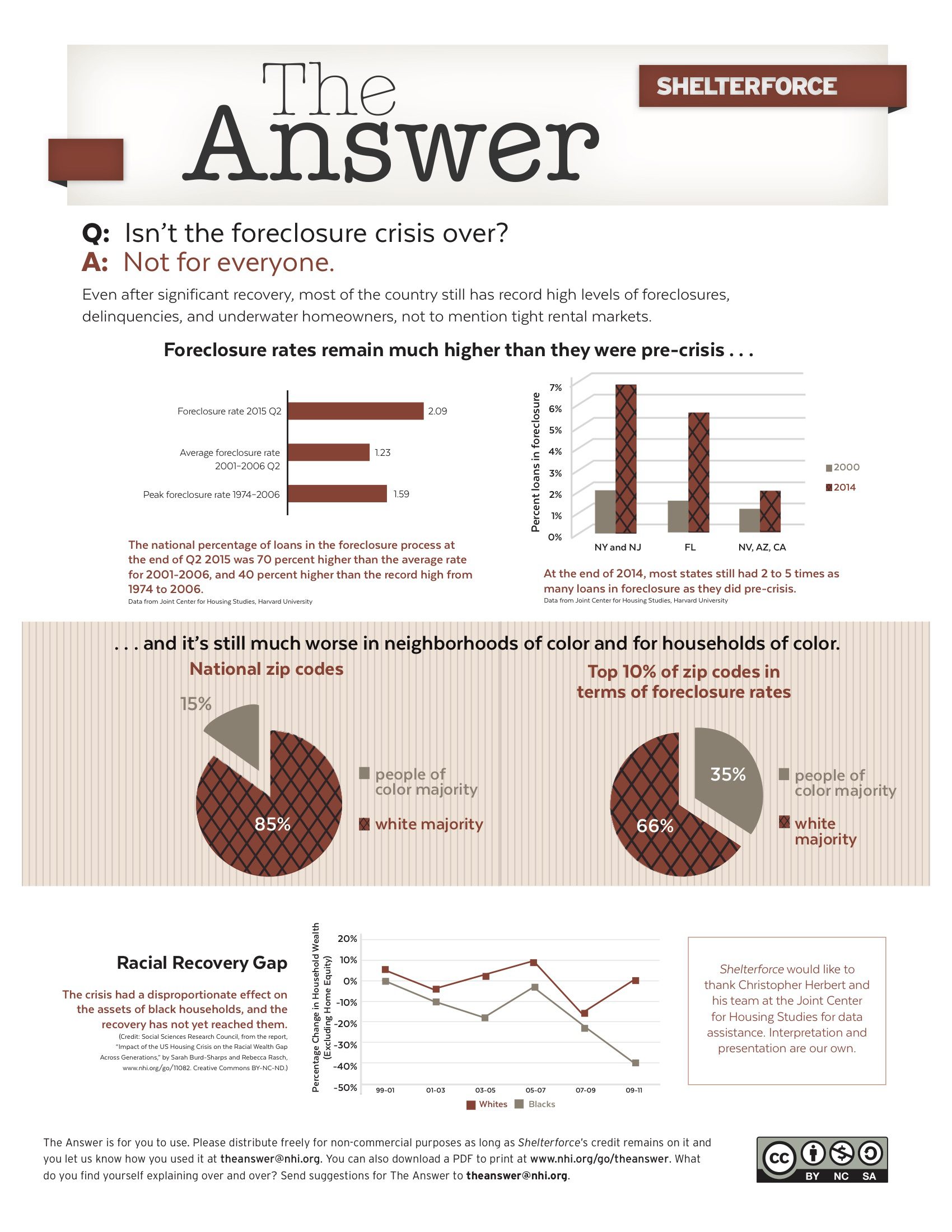
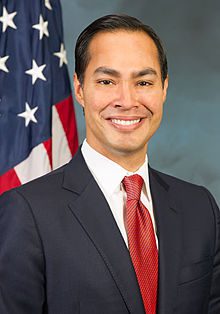
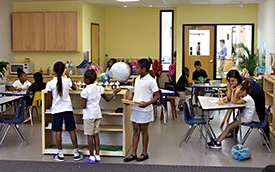
Comments